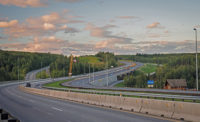ENR Northwest Best Projects
Project of the Year Finalist, Best Highway/Bridge: Kake Access Road

Photo courtesy Kiewit
Kake Access Road
Petersburg, Alaska
Best Highway/Bridge; Finalist – Project of the Year
Submitted By: Kiewit Infrastructure
Owner/Lead Design Firm: Alaska Dept. of Transportation & Public Facilities
General Contractor: Kiewit Infrastructure
The $34-million Kake Access Road project provides improved access to the remote Tongass National Forest on Kupreanof Island in southeast Alaska. The road also provides year-round surface transportation between the community of Kake and a new boat launch on the eastern shore of the island.
The Alaska Dept. of Transportation & Public Facilities project included 6.4 miles of greenfield road, 208,000 cu yd of shot rock borrow, a prefabricated steel girder bridge, 3,200 linear ft of culvert pipe, a 66-person camp and a boat launch in Frederick Sound. The roadway allows for emergency evacuation as well as recreational and subsistence activities. Its opening offers economic development opportunities between the communities of Kake and Petersburg and creates an additional access point to navigable waters on the sound.
The project’s remote location—only accessible by boat or float plane—dramatically complicated the procurement and transportation of materials. Due to limited service in the area, the project team was equipped with satellite phones and Garmin InReach navigational devices that utilized GPS tracking while providing texting capabilities. Each team member’s location was monitored, and all devices included a button to contact the Coast Guard, state troopers and emergency services.
Despite these challenges, the team completed the project more than one year ahead of schedule and reduced the estimated cost by $26 million by executing an aggressive project schedule.

Photo courtesy Kiewit
To minimize the impact of new construction for the roadway, the team utilized existing roads in the area. This change eliminated four of the originally planned bridges. Kiewit also recommended a prefabricated steel girder bridge, which was easier to transport and did not require batch plants or concrete pours.
By reducing the amount of road to 6.4 miles and constructing only one prefabricated steel girder bridge, Kiewit saved the client $25 million and secured state funding for the project. Kiewit was also able to save an additional $2 million by using less rock than required by the contract, enabling a portion of the funds to be redirected to improving current roads and bridges not originally included in the project scope.

Photo courtesy Kiewit
Material management was also essential due to the site’s remote location. The team had to develop a comprehensive logistics plan to ensure that both the camp and the project site had all the required food, materials and equipment at the scheduled time. Kiewit established close working relationships with local suppliers to have all necessities barged in twice a week.
While preparing to work on bedding material, ditch lining and structural fill, the project manager came across a screening bucket tool used frequently in Europe but never utilized by Kiewit in the U.S. This hydraulically driven, easy-to-use tool can be attached to excavators, wheel loaders, backhoe loaders or skid steers and can help reduce crushing times by up to 60%, allowing users to salvage materials suited to the type of job being carried out and to manage and reuse them in the best way possible. This innovative tool accelerated the bedding material process, resulting in schedule savings.



